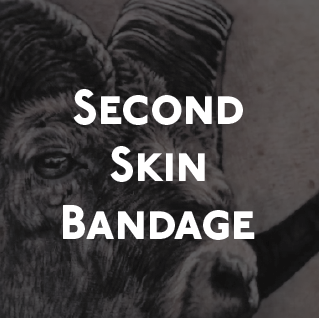The process of tattooing has been becoming more and more refined. It certainly has changed tremendously since it’s origin in ancient cultures. In recent years, tattooing has advanced at an immense rate. Everything from the inks that the artists use, to the machines and needles, standards of cleanliness – even aftercare! One of the best advances in aftercare is something referred to as ‘second skin’ bandages.
What Is A Second Skin Bandage?
It is quite literally what the name would suggest. A second skin bandage is a type of wrap that is applied once a tattoo is complete. It is a layer of flexible adhesive plastic that covers a fresh tattoo like a second layer of skin. They are easy to apply and remove, and offer a greater chance at protecting your tattoo than traditional methods of wrapping such as household saran wrap. There are numerous brands available on the market, but all of them work essentially the same way. The bandages are waterproof and can be worn in the shower but should not be submerged.
How Do They Work?
Once applied, the bandage will stay in place for 4 to 6 days (dependent on the artist advice, shop, or specific bandage). During that time, your new tattoo will be protected from bacteria or contaminants. It will also be protected from rubbing against clothes or linens such as towels or bed sheets. In most cases, this type of bandages also offers slightly faster healing. This is because it holds in the body’s natural healing processes and prevents the tattoo from drying out. Most of these bandages tend to be see through, so you’ll be able to see your new tattoo as it heals. With that being said, it is completely normal for ink or blood to pool under the bandage. This does not mean that your tattoo is ‘falling out’, it is simply residual or extra ink that the body is naturally pushing out in the form of plasma.
How Are They Applied?
A tattoo artist carefully and thoroughly clean the new tattoo. Pieces of bandage will be careful cut to size depending on how large the tattoo is, and what part of the body it is on. Most bandages have two sides: the sticky side that is placed down, and a sanitary backing that is meant to keep the bandage rigid and prevent it from sticking to itself before being applied. The sticky side is placed over the tattoo while making sure it’s secure and free of any large bubbles. Then the rigid backing is removed to reveal the non-sticky side of the bandage that faces outward.
How Are They Removed?
After a certain amount of time, the bandages should be carefully removed. Always start this process with clean hands! Begin by finding an edge that is easily loosened, and start by peeling at a slight angle. Always peel slowly and as evenly as possible, peeling too quickly could leave behind adhesive residue or hurt the skin underneath. If the bandage does not come off very easily, it can also be removed in a warm shower. Once removed, wash the tattoo using a non-scented antibacterial soap with warm water and then apply a small amount of non-scented moisturizer. Always wash in warm water vs hot to avoid irritating the tattoo, and use non-scented products for the same reason.
PROS:
- Sanitary
- Protects tattoo from bacteria, germs, and rubbing on clothes or other fabrics
- Protects clothes and other fabrics from tattoo leakage
- Often heals tattoos faster
- Breathable
- Simplifies aftercare
- Flexible and comfortable
- Waterproof
CONS:
- May not be recommended for those with skin sensitivities
- Avoid if you have allergies to adhesives
- May hurt a little bit to remove

